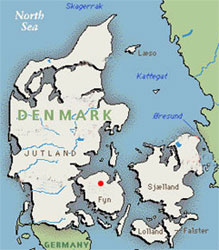Odense, Denmark
 |
|
Facts
Odense is the 3rd biggest city in Denmark, and used to be the traffic nerve centre of Denmark.
Odense was also once the centre of public administration and trade. The original name for Odense is "Odins", which means ‘Odin’s Sanctuary’. Odin is considered to be the most important God in Old Norse mythology. Prior to the acceptance of Christianity ‘Old Norse Mythology’ was the main pagan religion throughout Scandinavia. Odense was named ‘Odin’s Sanctuary’ because the town was considered a sanctuary for people who worshiped Odin.
Generally the city considers itself to be a somewhat forgotten part of Denmark. Many tourists unfortunately drive right past Odense on their way to or away from Copenhagen (København). This is unfortunate because Odense is well worth a visit. Odense makes much ado about their most famous citizen, Hans Christian Andersen, even though he only lived in Odense until he was 14 years old, and even though Hans Christian himself never spoke well of his impoverished beginnings in Odense. Neither of these facts has deterred the city from expressing great pride that Hans Christian was born in their city.
Odense has many quality museums and galleries. There are many pedestrian streets, good restaurants, and several interesting churches. The old town of Odense has more than its fair share of well preserved buildings which gives you a good idea about how life was in Odense during the Middle Ages.
Approximately 28 km south of Odense is Egeskov Castle (Egeskov Slot) which is considered to be one of Europe’s best preserved castles surrounded by a moat. Anyone visiting the island of Funen (Fyn) should take the time to visit this extraordinary castle. The castle grounds are quite simply beautiful and there are many different impeccably manicured gardens. The castle grounds also have a wide variety of museums to suit anyone’s interests, including an automotive museum, a motorcycle museum, several vintage flying machines, and museum dedicated to the history of agriculture.
History
Archaeological evidence suggests that Odense has been inhabited since the Stone Age. However, the first documented mention of Odense dates back to the year 988 when the town is mentioned in a letter from the German emperor Otto the 3rd. The letter gave the church in Odense exemption from taxes, and selected the city as a bishop's domicile. It is for this reason that the town celebrated its 1000 anniversary in 1988. Part of the celebration involved the cultivation of a new forest named "The Thousand Year Forest" (Tusindårsskoven).
It is clear that Odense grew quite quickly after it had first been mentioned in 988. In 1070, a mere 82 years later Odense was commonly being referred to as being a big city.
In 1086, King Canute IV of Denmark (Knud den Hellige) was murdered in the former Church of St. Alban by peasants who were unhappy with the high taxation in the city. Canute IV is commonly thought of as being the last Viking king. The Albani Church no longer exists, however there has continued to be a church on the location since approximately 900. The current church is called St. Canute's Cathedral (Odense Domkirke or Sct. Knuds Kirke), and the crypt holds the remains of Canute and his brother Benedict.
After Saint Canute's death he was recognized as the patron saint of Denmark by the Catholic Church. This had the effect that during the Middle Ages the shrine of Saint Canute inside Saint Canute's Cathedral was visited by many pilgrims.
During the 18th century an enormous project was undertaken which would dramatically change the city. An 8 kilometre long channel was built from the Odense Harbour to Odense Fjord. The construction of this channel turned Odense into a real port city, and commerce and the population increased dramatically.
In 1865 a railway was built across Funen which would also have great effects on Odense’s commerce.
Since 1966 Odense has been known as a university city. The city is also has an Opera and a Symphony Orchestra. Since the 1960's Odense has been the home of many trade shows at the enormous exhibition centre (Odense Congress Center).
2005 marked a special year in Odense as the city celebrated the 200 anniversary of the birth of Hans Christian Andersen.
Odense - Things to See and Do (Part 1)
Odense - Things to See and Do (Part 2)
LastUpdate: 2019-06-28 21:13:05
